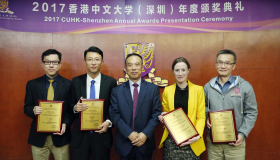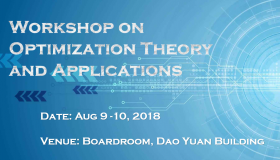CUHK-Shenzhen Wins Second Prize at Intelligent Car Race
The NXP Cup
The NXP Cup National University Students Intelligent Car Race (the NXP Cup) was originally known as the Freescale Cup. It is a first-of-its-kind competition hosted by the Department of Higher Education (Ministry of Education) which has become one of the most influential technology innovation and practice competitions featuring contestants from nearly 500 universities in over 30 provinces. It has grown from three events to seven including light and electricity. The NXP Cup requires its contestants to use microcontrollers as main control units, apply road sensors and motor drivers, and write programs to design and assemble smart cars that could independently identify track conditions and objects. It challenges contestants with vehicle engineering, assembling unmanned aerial vehicles (UAVs), and controller and actuator optimization.
About Cheng Dao 419
A total of nearly 200 teams comprising 1800 students from 166 universities participated in the final. Cheng Dao 419 consisted of three senior Electronic Information Engineering students: Wei Yingxin, Du Jingxin, and Liu Yuanhao, and a year 2 doctoral student, Niu Guanchong.

(From left) Members of “Cheng Dao 419”: Du Jingxin, Wei Yingxin, and Liu Yuanhao; and Prof. Simon Pun, SSE
Cheng Dao 419 joined the NXP Cup because “unmanned ground vehicles (UGVs) and UAVs have been hot topics in research in recent years.” They commented that the quadrotor race was a great drawcard and that they hoped to deepen their knowledge of smart cars and UAVs whilst inspiring the CUHK -Shenzhen spirit for innovation and practice. “We’d like to thank our school and CIDE for their great support, and extend our sincere gratitude to Prof. Pun. They helped us make our dreams finally come true.”
Team members reflected that high technology and smart manufacturing were their research topics. “We applied Raspberry Pi to operate OpenCV to recognize beacons, parallel computing to optimize OpenCV to speed up distortion correction, 850nm filters to wide-angle lenses to filter stray light, and the IoT to control 3D printers to facilitate remote printing. Through CATIA, we designed a crash barrier and printed it out with a 3D printer. We also applied SDR to debug our models to improve their anti-jamming capability and PixHawk, an open source autopilot, to make our UAVs…The results speak for themselves.”

Quadrotor models assembled by Cheng Dao 419 at the 12th NXP Cup
“We are lucky our university is located in Shenzhen, the ‘Silicon Valley’ in China. Therefore, the electronic components needed are easily accessible. For example, we found a component in Huaqiang North shopping mall. Teams from other cities were not that lucky. Our competitor from Beijing broke its wide-angle lens but could not get a new one in time, which greatly impacted their performance. We feel we are so lucky to live in Shenzhen.”
Although their efforts yielded positive results, team members acknowledge the gap between them and their competitors. “We lacked experience in comparison to the top teams like the Harbin Institute of Technology. It was our first time, but they have competed in the race for five consecutive years. Therefore, we learn much from competing with them.”
“The NXP Cup allowed us to access to a wonderland of engineering, electrical circuits, and programming. We assembled components, designed mechanical structures and electrical circuits, applied drivers and algorithms, and finally assembled a UGV and a UAV, letting them work together to carry out tasks. We spent day and night designing electrical circuits, coding, and debugging smart cars and quadrotor models together - a long and painful but ultimately rewarding process. We were happy to see our smart cars and UAVs finished. Pain and happiness were intertwined in those days.”
Back to university
On returning to school, members found room for improvement. Prof. Stephen Boyd from Stanford University visited CUHK-Shenzhen and watched their smart car demonstration. As a master of control theory, he spent two days instructing team members about trajectory optimization for a smart car running at high speed with local control. Before he returned to Stanford, Prof. Boyd asked the team members to send him updates.
Cheng Dao 419 members sincerely thank all members of the Cheng Dao 419 Lab for their support, in particular, engineers Mr. Hou Liang and Mr. Yang Lujian.
Supported by Prof. Simon Pun and Prof. Stephen Boyd, the team is planning to organize a student group on smart manufacturing research open to all CUHK-Shenzhen students.

Prof. Stephen Boyd and Prof. Simon Pun guiding team members




